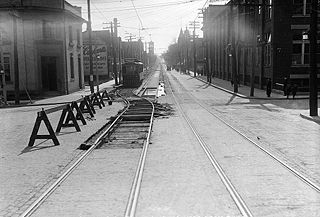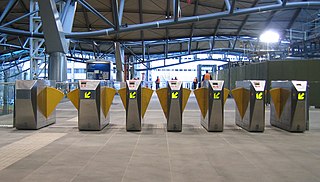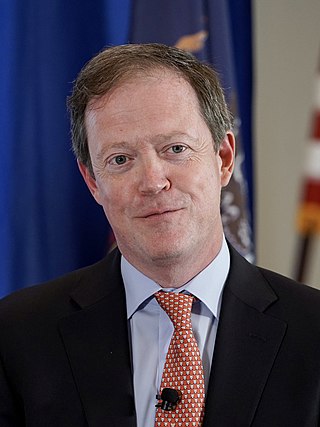
The Massachusetts Bay Transportation Authority is the public agency responsible for operating most public transportation services in Greater Boston, Massachusetts. The MBTA transit network includes the MBTA subway with three metro lines, two light rail lines, and a five-line bus rapid transit system ; MBTA bus local and express service; the twelve-line MBTA Commuter Rail system, and several ferry routes. In 2023, the system had a ridership of 239,981,700, or about 755,500 per weekday as of the fourth quarter of 2023, of which the rapid transit lines averaged 267,100 and the light rail lines 80,300, making it the fourth-busiest rapid transit system and the third-busiest light rail system in the United States. As of the fourth quarter of 2023, average weekday ridership of the commuter rail system was 97,100, making it the fifth-busiest commuter rail system in the U.S.

The Toronto Transit Commission (TTC) is the public transport agency that operates bus, subway, streetcar, and paratransit services in Toronto, Ontario, Canada, some of which run into the Peel Region and York Region. It is the oldest and largest of the urban transit service providers in the Greater Toronto Area, with numerous connections to systems serving its surrounding municipalities.

The Red Line is a rapid transit line operated by the Massachusetts Bay Transportation Authority (MBTA) as part of the MBTA subway system. The line runs south and east underground from Alewife station in North Cambridge through Somerville and Cambridge, surfacing to cross the Longfellow Bridge then returning to tunnels under Downtown Boston. It continues underground through South Boston, splitting into two branches on the surface at JFK/UMass station. The Ashmont branch runs southwest through Dorchester to Ashmont station, where the connecting light rail Ashmont–Mattapan High Speed Line continues to Mattapan station. The Braintree branch runs southeast through Quincy and Braintree to Braintree station.

The Orange Line is a rapid transit line operated by the Massachusetts Bay Transportation Authority (MBTA) as part of the MBTA subway system. The line runs south on the surface from Oak Grove station in Malden, Massachusetts through Malden and Medford, paralleling the Haverhill Line, then crosses the Mystic River on a bridge into Somerville, then into Charlestown. It passes under the Charles River and runs through Downtown Boston in the Washington Street Tunnel. The line returns to the surface in the South End, then follows the Southwest Corridor southwest in a cut through Roxbury and Jamaica Plain to Forest Hills station.

The Red Line is a rapid transit line of the Washington Metro system, consisting of 27 stations in Montgomery County, Maryland, and Washington, D.C., in the United States. It is a primary line through downtown Washington and the oldest and busiest line in the system. It forms a long, narrow "U," capped by its terminal stations at Shady Grove and Glenmont.

Line 4 Sheppard is the newest and shortest subway line of the Toronto subway system, operated by the Toronto Transit Commission (TTC). It opened on November 22, 2002, and has five stations along 5.5 kilometres (3.4 mi) of track, which is built without any open sections in the district of North York along Sheppard Avenue East between Yonge Street and Don Mills Road. All stations are wheelchair accessible and are decorated with unique public art.

North Station is a commuter rail and intercity rail terminal station in Boston, Massachusetts. It is served by four MBTA Commuter Rail lines – the Fitchburg Line, Haverhill Line, Lowell Line, and Newburyport/Rockport Line – and the Amtrak Downeaster intercity service. The concourse is located under the TD Garden arena, with the platforms extending north towards drawbridges over the Charles River. The eponymous subway station, served by the Green Line and Orange Line, is connected to the concourse with an underground passageway.

The Washington Metropolitan Area Transit Authority, commonly referred to as Metro, is a tri-jurisdictional public transit agency that operates transit service in the Washington metropolitan area. WMATA was created by the United States Congress as an interstate compact between Washington, D.C., Maryland, and Virginia.

The MBTA Commuter Rail system serves as the commuter rail arm of the Massachusetts Bay Transportation Authority's (MBTA's) transportation coverage of Greater Boston in the United States. Trains run over 394 mi (634 km) of track to 134 stations. It is operated under contract by Keolis, which took over operations on July 1, 2014, from the Massachusetts Bay Commuter Railroad Company (MBCR).

The history of public transportation in Toronto in Canada dates back to the middle 19th century under many different private companies, organizations and owners, which were all later unified as a single government-run entity during the 1920s.
Richard C. Ducharme P.Eng. has served as an administrator for several Canadian transit and transportation authorities, most recently as General Manager of Transportation for the City of Edmonton.
Gary M. Webster is the former Chief General Manager of the Toronto Transit Commission in Toronto, Ontario, Canada.

The history of the Massachusetts Bay Transportation Authority (MBTA) and its predecessors spans two centuries, starting with one of the oldest railroads in the United States. Development of mass transportation both followed existing economic and population patterns, and helped shape those patterns.

During the afternoon rush hour of June 22, 2009, a subway train wreck occurred between two southbound Red Line Washington Metro trains in Northeast, Washington, D.C., United States. A moving train collided with a train stopped ahead of it; the train operator along with eight passengers died, and 80 people were injured, making it the deadliest crash in the history of the Washington Metro.

An automated fare collection (AFC) system is the collection of components that automate the ticketing system of a public transportation network – an automated version of manual fare collection. An AFC system is usually the basis for integrated ticketing.

Richard A. Davey is an American attorney and transportation executive who is the President of the New York City Transit Authority. He was the Massachusetts Secretary of Transportation from September 2011 to October 2014 and previously the General Manager of the Massachusetts Bay Transportation Authority from March 2010 to September 2011.

Andrew Byford is a British transport executive who has held several management-level positions in transport authorities around the world, such as the Toronto Transit Commission (TTC), New York City's Metropolitan Transportation Authority (MTA), Transport for London (TfL), Sydney's then RailCorp, and currently Amtrak.

Hillcrest Complex, the Toronto Transit Commission's largest facility, is responsible for most of the maintenance work on the system's surface vehicles, including heavy overhauls, repairs, and repainting. It is located adjacent to the intersection of Bathurst Street and Davenport Road. The site is also home to the TTC's Transit Control Centre, but the operational headquarters of the organization remains at the McBrien Building, at 1900 Yonge Street.
Thomas J. McLernon was an American transportation executive who served as general manager of the New York City Transit Authority and the Massachusetts Bay Transportation Authority.
Richard J. Leary is an American and Canadian civil servant who has been the chief executive officer (CEO) of the Toronto Transit Commission (TTC) since 2017. Leary became interim CEO in 2017 following the departure of Andy Byford and took over the role permanently in 2018. Leary was previously general manager of York Region Transit and held senior roles with the Massachusetts Bay Transportation Authority (MBTA).
















